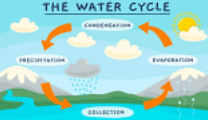Olympiad Test Level 1: Soil, Water and Weather - Class 3 MCQ
20 Questions MCQ Test - Olympiad Test Level 1: Soil, Water and Weather
Mrs. Sharma reuses water which was used to wash vegetables, to water her plants. This is a type of water-
Select the odd one out among the following natural source of water
| 1 Crore+ students have signed up on EduRev. Have you? Download the App |
Water droplets which are bigger and heavier to float are in
State true and false for the following statement (T = True, F = False) -
(i) Plants grow mostly in bed rock..
(ii) Soil is formed by the breakdown of rocks.
(iii) There are two layers of soil on the horizon.
(iv) Largest soil particles are Clay.
T = True
F = False
Among the following which does not attain the shape of the container:
Which among the following affects the weather-
Plants and Animals that live on both land and water are called.
Which of the following does NOT disturb the balance of gases in the air?
While boiling water at 100°C, what you will observe
Which among the following do not take part in soil formation.
Select the odd one out of the following-
Study the given figure and answer

What happens right after water flows to the ocean?
Which of the following changes weather?
State the correct option showing true(T) or False (F).
(i) Weather becomes unpleasant and uncomfortable during spring.
(ii) Excess rain causes floods.
(iii) Chilly wind blows during winters.
(iv) Clothes dry fastest in Autumn season.
Due to fog, which season has zero visibility in the morning?
From which layer of soil do plants get their nutrients?

















